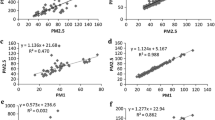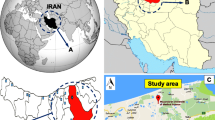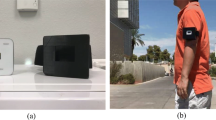Abstract
We conducted multiday continuous monitoring of indoor and outdoor particulate matter (PM) in classrooms with fan-assisted natural ventilation (NV) at five primary schools in Singapore. We monitored size-resolved number concentration of PM with diameter 0.3–10 μm at all schools and alveolar deposited surface area concentrations of PM with diameter 0.01–1.0 μm (SA0.01–1.0) at two schools. Results show that, during the monitoring period, schools closer to expressways and in the downtown area had 2–3 times higher outdoor PM0.3–1.0 number concentrations than schools located in suburban areas. Average indoor SA0.01–1.0 was 115–118 μm2 cm−3 during periods of occupancy and 72–87 μm2 cm−3 during unoccupied periods. There were close indoor and outdoor correlations for fine PM during both occupied and unoccupied periods (Pearson’s r = 0.84–1.0) while the correlations for coarse PM were weak during the occupied periods (r = 0.13–0.74). Across all the schools, the size-resolved indoor/outdoor PM ratios (I/O ratios) were 0.81 to 1.58 and 0.61 to 0.95 during occupied and unoccupied periods, respectively, and average infiltration factors were 0.64 to 0.94. Average PM net emission rates, calculated during periods of occupancy in the classrooms, were lower than or in the lower range of emission rates reported in the literature. This study also reveals that indoor fine and submicron PM predominantly come from outdoor sources, while indoor sources associated with occupancy may be important for coarse PM even when the classrooms have high air exchange rates.







Similar content being viewed by others
References
Almeida-Silva M, Almeida SM, Gomes JF, Albuquerque PC, Wolterbeek HT (2014) Determination of airborne nanoparticles in elderly care centers. J Toxicol Environ Health A 77:867–878
Alshitawi MS, Awbi HB (2011) Measurement and prediction of the effect of students’ activities on airborne particulate concentration in a classroom. HVAC&R Res 17:446–464
ASTM (2012) D 6245–12: Standard guide for using indoor carbon dioxide concentrations to evaluate indoor air quality and ventilation, ASTM standard. ASTM International, West Conshohocken
Bordado JC, Gomes JF, Albuquerque PC (2012) Exposure to airborne ultrafine particles from cooking in Portuguese homes. J Air Waste Manage Assoc 62:1116–1126
Braniš M, Šafránek J, Hytychová A (2011) Indoor and outdoor sources of size-resolved mass concentration of particulate matter in a school gym—implications for exposure of exercising children. Environ Sci Pollut Res 18:598–609
Buonanno G, Fuoco FC, Morawska L, Stabile L (2013) Airborne particle concentrations at schools measured at different spatial scales. Atmos Environ 67:38–45
Chao CYH, Wan MP, Cheng ECK (2003) Penetration coefficient and deposition rate as a function of particle size in non-smoking naturally ventilated residences. Atmos Environ 37:4233–4241
Chen C, Zhao B (2011) Review of relationship between indoor and outdoor particles: I/O ratio, infiltration factor and penetration factor. Atmos Environ 45:275–288
Davidson CI, Phalen RF, Solomon PA (2005) Airborne particulate matter and human health: A review. Aerosol Sci Technol 39:737–749
Dorizas PV, Assimakopoulos M-N, Helmis C, Santamouris M (2015) An integrated evaluation study of the ventilation rate, the exposure and the indoor air quality in naturally ventilated classrooms in the Mediterranean region during spring. Sci Total Environ 502:557–570
Fromme H, Twardella D, Dietrich S, Heitmann D, Schierl R, Liebl B, Rüden H (2007) Particulate matter in the indoor air of classrooms—exploratory results from Munich and surrounding area. Atmos Environ 41:854–866
Gall ET, Chen A, Chang VW-C, Nazaroff WW (2015) Exposure to particulate matter and ozone of outdoor origin in Singapore. Build Environ 93(Part 1):3–13
Gatto M, Gariazzo C, Gordiani A, L’Episcopo N, Gherardi M (2014) Children and elders exposure assessment to particle-bound polycyclic aromatic hydrocarbons (PAHs) in the city of Rome, Italy. Environ Sci Pollut Res 21:13152–13159
Gomes JFP, Bordado JCM, Albuquerque PCS (2012) On the assessment of exposure to airborne ultrafine particles in urban environments. J Toxicol Environ Health A 75:1316–1329
Goyal R, Khare M (2009) Indoor–outdoor concentrations of RSPM in classroom of a naturally ventilated school building near an urban traffic roadway. Atmos Environ 43:6026–6038
Guo H, Morawska L, He C, Gilbert D (2008) Impact of ventilation scenario on air exchange rates and on indoor particle number concentrations in an air-conditioned classroom. Atmos Environ 42:757–768
Guo H, Morawska L, He C, Zhang YL, Ayoko G, Cao M (2010) Characterization of particle number concentrations and PM2.5 in a school: Influence of outdoor air pollution on indoor air. Environ Sci Pollut Res 17:1268–1278
Gupta A, Cheong DKW (2007) Physical characterization of particulate matter and ambient meteorological parameters at different indoor–outdoor locations in Singapore. Build Environ 42:237–245
Habil M, Taneja A (2011) Children’s exposure to indoor particulate matter in naturally ventilated schools in India. Indoor Built Environ 20:430–448
Hosgood HD, Lan Q, Vermeulen R, Wei H, Reiss B, Coble J, Wei F, Jun X, Wu G, Rothman N (2012) Combustion-derived nanoparticle exposure and household solid fuel use in Xuanwei and Fuyuan, China. Int J Environ Health Res 22:571–581
Kloog I, Nordio F, Zanobetti A, Coull BA, Koutrakis P, Schwartz JD (2014) Short term effects of particle exposure on hospital admissions in the Mid-Atlantic states: A population estimate. PLoS ONE 9:e88578
Kumar P, Ketzel M, Vardoulakis S, Pirjola L, Britter R (2011) Dynamics and dispersion modelling of nanoparticles from road traffic in the urban atmospheric environment—a review. J Aerosol Sci 42:580–603
Lee SC, Chang M (2000) Indoor and outdoor air quality investigation at schools in Hong Kong. Chemosphere 41:109–113
Long CM, Suh HH, Catalano PJ, Koutrakis P (2001) Using time- and size-resolved particulate data to quantify indoor penetration and deposition behavior. Environ Sci Technol 35:2089–2099
Mendell MJ, Heath GA (2005) Do indoor pollutants and thermal conditions in schools influence student performance? A critical review of the literature. Indoor Air 15:27–52
Moshammer H, Neuberger M (2003) The active surface of suspended particles as a predictor of lung function and pulmonary symptoms in Austrian school children. Atmos Environ 37:1737–1744
Mullen NA, Bhangar S, Hering SV, Kreisberg NM, Nazaroff WW (2011) Ultrafine particle concentrations and exposures in six elementary school classrooms in northern California. Indoor Air 21:77–87
Ntziachristos L, Polidori A, Phuleria H, Geller MD, Sioutas C (2007) Application of a diffusion charger for the measurement of particle surface concentration in different environments. Aerosol Sci Technol 41:571–580
Pope CA III (2000) Epidemiology of fine particulate air pollution and human health: biologic mechanisms and who’s at risk? Environ Health Perspect 108:713–723
Qian J, Peccia J, Ferro AR (2014) Walking-induced particle resuspension in indoor environments. Atmos Environ 89:464–481
Rim D, Wallace LA, Persily AK (2013) Indoor ultrafine particles of outdoor origin: Importance of window opening area and fan operation condition. Environ Sci Technol 47:1922–1929
Sabbagh-Kupelwieser N, Horvath H, Szymanski WW (2010) Urban aerosol studies of PM1 size fraction with reference to ambient conditions and visibility. Aerosol Air Qual Res 10:425–432
SPRING (2009) SS 553: 2009. Code of practice for air-conditioning and mechanical ventilation in buildings. SPRING, Singapore
Tippayawong N, Khuntong P, Nitatwichit C, Khunatorn Y, Tantakitti C (2009) Indoor/outdoor relationships of size-resolved particle concentrations in naturally ventilated school environments. Build Environ 44:188–197
Valavanidis A, Fiotakis K, Vlachogianni T (2008) Airborne particulate matter and human health: Toxicological assessment and importance of size and composition of particles for oxidative damage and carcinogenic mechanisms. J Environ Sci Health Pt C 26:339–362
Wang M, Zhu T, Zheng J, Zhang R, Zhang S, Xie X, Han Y, Li Y (2009) Use of a mobile laboratory to evaluate changes in on-road air pollutants during the Beijing 2008 Summer Olympics. Atmos Chem Phys 9:8247–8263
Wilson WE, Mage DT, Grant LD (2000) Estimating separately personal exposure to ambient and nonambient particulate matter for epidemiology and risk assessment: Why and how. J Air Waste Manage Assoc 50:1167–1183
Wu CD, MacNaughton P, Melly S, Lane K, Adamkiewicz G, Durant JL, Brugge D, Spengler JD (2014) Mapping the vertical distribution of population and particulate air pollution in a near–highway urban neighborhood: implications for exposure assessment. J Expo Sci Environ Epidemiol 24:297–304
Zhang Q, Zhu Y (2012) Characterizing ultrafine particles and other air pollutants at five schools in South Texas. Indoor Air 22:33–42
Zuraimi MS (2007) Estimates of associated outdoor particulate matter health risk and costs reductions from alternative building, ventilation and filtration scenarios. Sci Total Environ 377:1–11
Zuraimi MS, Tham KW, Chew FT, Ooi PL (2007) The effect of ventilation strategies of child care centers on indoor air quality and respiratory health of children in Singapore. Indoor Air 17:317–327
Acknowledgments
This research is funded by the Republic of Singapore’s National Research Foundation through a grant to the Berkeley Education Alliance for Research in Singapore (BEARS) for the Singapore-Berkeley Building Efficiency and Sustainability in the Tropics (SinBerBEST) Program. BEARS has been established by the University of California, Berkeley as a center for intellectual excellence in research and education in Singapore.
Author information
Authors and Affiliations
Corresponding author
Additional information
Responsible editor: Gerhard Lammel
Rights and permissions
About this article
Cite this article
Chen, A., Gall, E.T. & Chang, V.W.C. Indoor and outdoor particulate matter in primary school classrooms with fan-assisted natural ventilation in Singapore. Environ Sci Pollut Res 23, 17613–17624 (2016). https://doi.org/10.1007/s11356-016-6826-7
Received:
Accepted:
Published:
Issue Date:
DOI: https://doi.org/10.1007/s11356-016-6826-7




